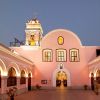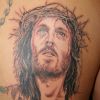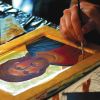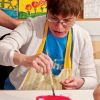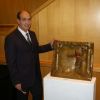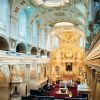LIMA, Peru - Half-hidden behind palm trees at the end of a once elegant avenue in a now rundown neighborhood, the Convento de los Descalzos -- the Convent of the Barefoot Friars -- has witnessed half a millennium of Peruvian history.
Age, economic woes and benign neglect have taken their toll, and the convent has fallen on hard times. But Alberta Alvarez, the director of a foundation established less than a year ago to revitalize the convent, is trying to change that.
Religious tattoos create ‘billboards for Christ’
TORONTO - While getting a tattoo may not be considered the holiest practice, it shouldn’t always be perceived as devilish.
“Religious tattoos are a sign of faith,” said Jason Gennaro, creator of religioustattoos.net. “Those who tattoo themselves with Christian symbols of faith are displaying a belief that many try to subjugate and hide.”
A father of five, devoted husband and faithful Catholic, Gennaro currently has 18 tattoos, 14 of which directly link to his faith. The other four need a little explanation to expose the religious relevance which Gennaro insists exists. “My tattoo choices are the result of prayer,” said Gennaro. “I will be struck by something I read in a book or see in a church. I take those items to prayer and let my conversations with God guide me.”
Exploring art’s religious angle
Engaging in a retreat often suggests a certain solitude while withdrawing from the world to contemplate and renew. The summer programs at Living Water College in Derwent, Alta. combine both mental and spiritual renewal with intensive arts studies to create unique experiences.
College president Deacon Kenneth Noster describes the programs as a “a great opportunity to develop skills, while refreshing your mind and spirit amidst some of Alberta's most beautiful countryside.”
“No matter what your faith background, you will grow here,” he said.
The college has enlisted instructors with an impressive range of experience to teach two courses — Iconography and Sacred Polyphony — being offered in July and August respectively. In keeping with Living Water's central tenets (art, faith and reason) the courses are designed to promote artistic and spiritual growth.
“That's one of the reasons why we've crafted the course the way we have,” said instructor Frank C. Turner, who has been studying iconography since 1991. “You can learn the physical techniques of iconography, and you can get okay results. But icon is a prayer.
“As Thomas Aquinas says: 'Prayer is the raising of the mind and heart to God.' Iconography is the raising of inanimate substances to the glory of God. And so that's a prayer.”
Part of the iconography experience involves creating an egg tempera paint solution by mixing one part liquid egg yolk, two parts white wine and essence of lavender. That particular mixture, which pre-dates Christianity, was taught to Turner by master iconographer Fr. Gianluca Busi while studying in Italy.
“In many ways, I mean, I have a great devotion to iconography because of the subject, but the little techniques within the process are very fascinating,” Turner said. “I really enjoy making my egg emulsion every time.”
Turner believes artistic workshops set in a religious context work much better than those that are simply a craft workshop.
Sacred Polyphony is similar. The course seeks to explore some of the Church's oldest musical repertoire through polyphony and Gregorian chant. Maestro Uwe Lieflander, the instructor, has a strong musical pedigree, having studied at the Regensburg Akademie für Kirchenmusik in Germany and at The Royal Conservatory of Music in Toronto.
In addition to studying the complexities of the music, which formed the foundation for choral music as we know it today, students perform Franz Schubert's second setting of the Latin Mass, his Mass in G major, as well as Vivaldi's Gloria. Both works provide opportunity for vocal coaching for singers of all levels and solo work for professionals.
Both the iconography and polyphony programs combine a spiritual element with a precise study of two of the Church's oldest and most celebrated art forms.
Exhibit showcases L’Arche artists
Biologically speaking, we can sustain life without art, but it wouldn’t be a very human life. L’Arche is all about sustaining and celebrating a fully human life, which makes the April art exhibition at the Richmond Hill Centre for the Performing Arts so important, said Colette Halferty.
Halferty is part of the team at L’Arche Daybreak putting on With Our Own Hands, an art exhibition featuring the work of L’Arche core members and other artists who participate in L’Arche day programs.
Since every saint has a story, artist Caruso will try to tell it
RICHMOND HILL, Ont. - Artist Antonio Caruso’s Catholic faith has influenced him from a very young age. And as a sculptor and painter, it has had a strong impact on the artist he became and the various religious subjects he pursues.
Growing up in a very religious family in Italy, he lost his father when he was only 13 years old.
“But I always had visions of my father through Jesus,” said Caruso, who moved to Canada permanently with his family in 1995. The artist now lives in Woodbridge, Ont.
Culture has turned into Quebec’s new religion
QUEBEC CITY - It used to be that Quebecers who wanted to hear good preaching or be instructed on right and wrong went to Mass on Sunday and listened to their priest. The clergy were the principle arbiters of public and private morality in all spheres of life in Quebec. They preached on everything from how to dress, who to consort with (or not) and what to read, think vote and so on.
One famous saying from this era — “heaven is blue and hell is red” — was a not-so-veiled reference to vote Conservative in elections. The Church believed the “red” Liberals stood for secular reform and social change that would lead people away from their faith. And that’s what happened, people eventually voted red in order to hasten improvements in material living standards and, as predicted, what eventually followed was a widespread abandonment of faith in Quebec.


